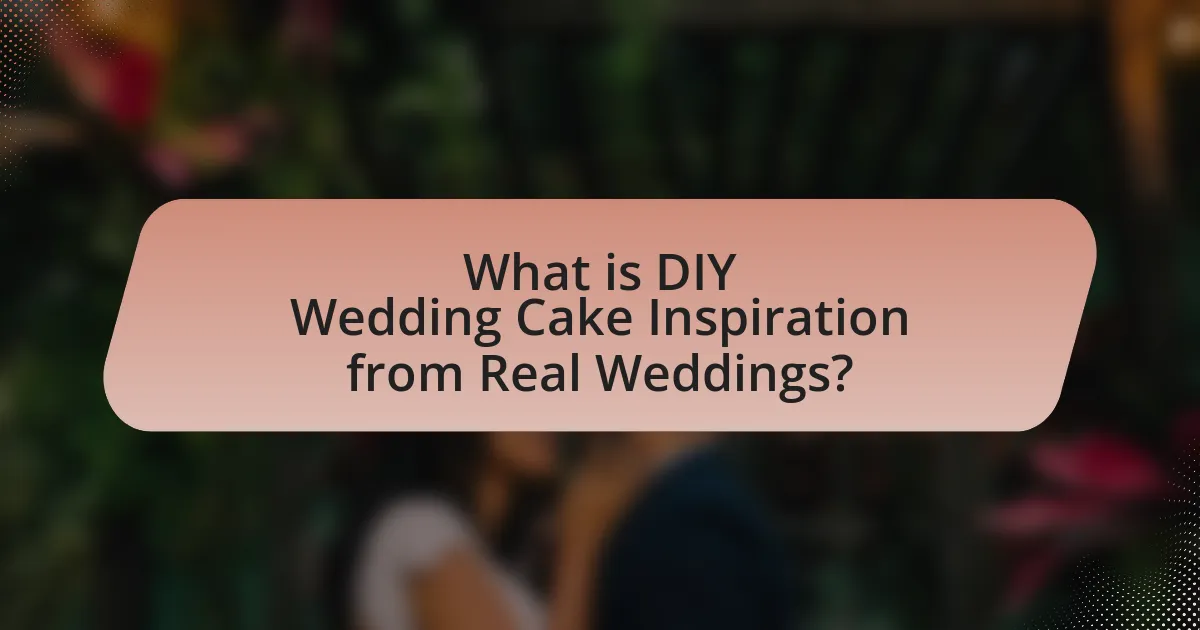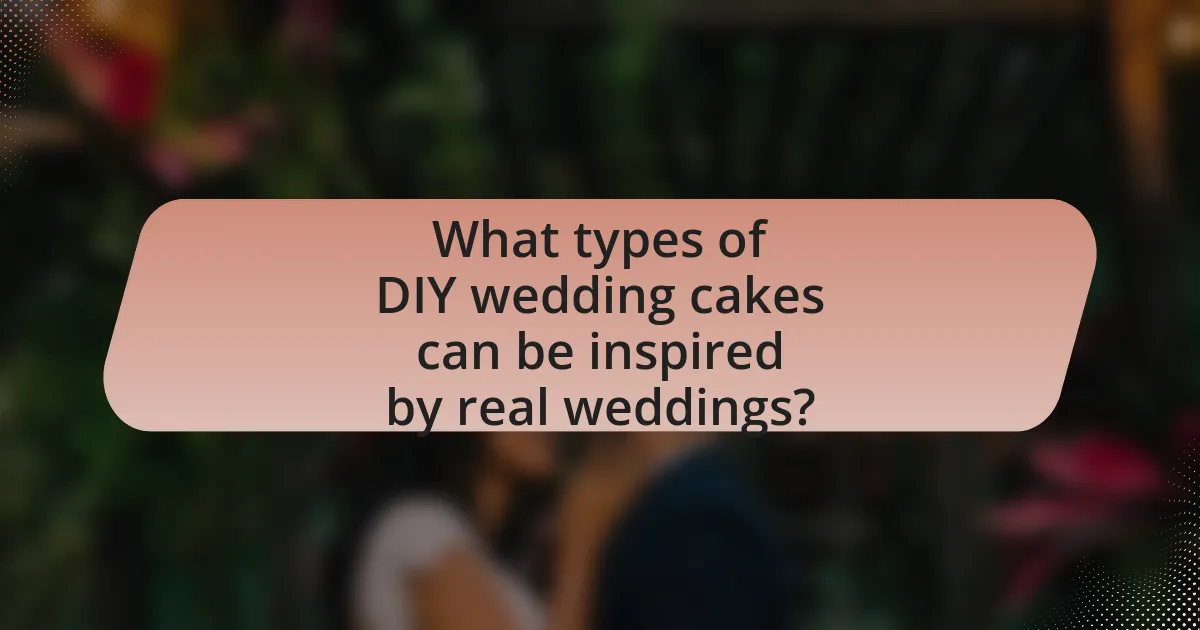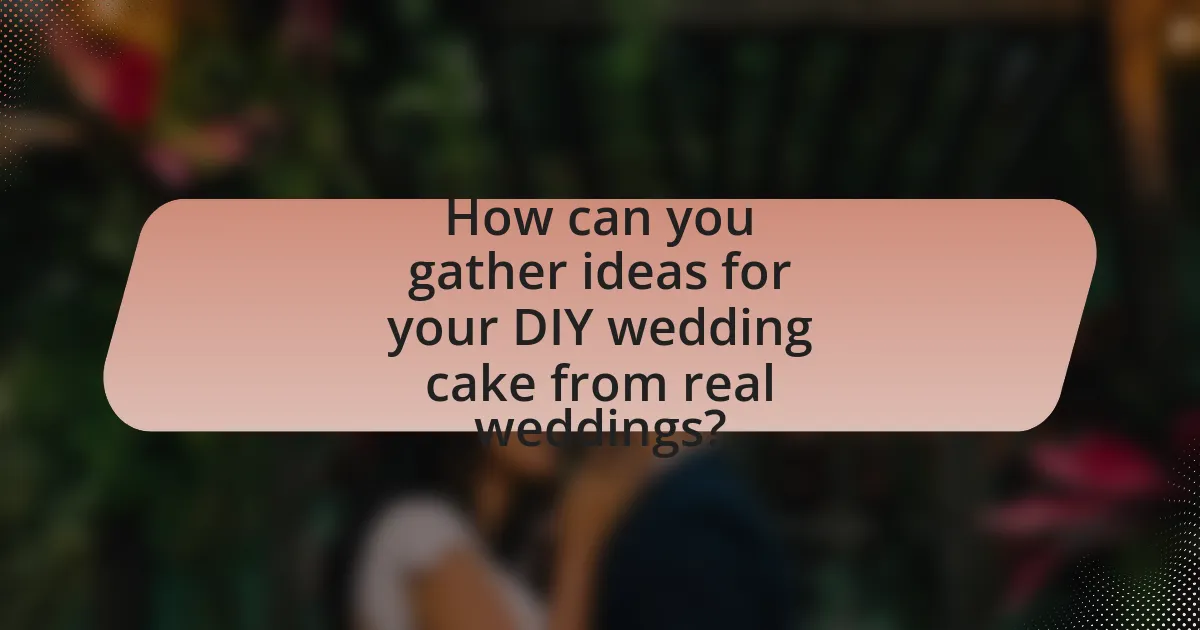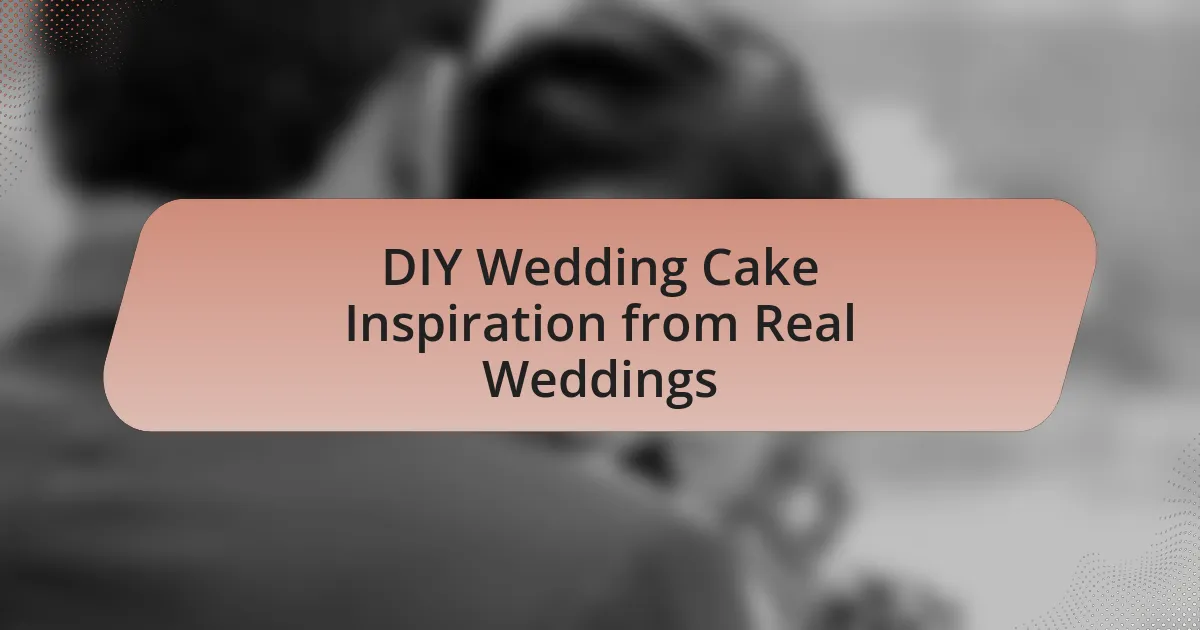DIY wedding cake inspiration from real weddings encompasses creative ideas and designs that couples have implemented in their own cakes, reflecting personal styles and preferences. The article explores how real weddings provide valuable insights into unique cake designs, flavors, and themes, highlighting elements such as intricate decorations, seasonal ingredients, and thematic influences. It discusses the benefits of choosing a DIY wedding cake, including personalization, cost savings, and the opportunity for couples to create a meaningful centerpiece for their celebration. Additionally, the article addresses common challenges faced in DIY cake creation and offers practical tips for successful execution, ensuring that couples can effectively adapt inspiration from real weddings to fit their vision.

What is DIY Wedding Cake Inspiration from Real Weddings?
DIY wedding cake inspiration from real weddings refers to creative ideas and designs that couples have implemented in their own wedding cakes, showcasing personal touches and unique styles. Many couples opt for DIY wedding cakes to reflect their personalities, often incorporating elements such as seasonal flowers, favorite flavors, or cultural traditions. For instance, a couple might choose a naked cake adorned with fresh berries and greenery, inspired by rustic themes seen in various real weddings. Additionally, online platforms like Instagram and Pinterest serve as valuable resources, where couples can find visual examples and tutorials based on actual weddings, further validating the trend of personalized DIY wedding cakes.
How can real weddings provide inspiration for DIY wedding cakes?
Real weddings provide inspiration for DIY wedding cakes by showcasing unique designs, flavors, and themes that couples have successfully implemented. Observing actual wedding cakes allows DIY bakers to gather ideas on decoration styles, such as floral arrangements, color palettes, and tiered structures, which can be adapted to their own preferences. Additionally, real weddings often highlight trending flavors and innovative combinations, enabling DIY bakers to experiment with popular choices like red velvet or lemon zest. This practical exposure to diverse cake presentations and flavor profiles serves as a valuable resource for creating personalized and memorable wedding cakes.
What elements of real wedding cakes are most inspiring for DIY projects?
The most inspiring elements of real wedding cakes for DIY projects include intricate designs, unique flavor combinations, and personalized decorations. Intricate designs, such as lace patterns or floral motifs, can be replicated using fondant or edible lace, allowing DIY bakers to achieve a professional look. Unique flavor combinations, like lavender and lemon or chocolate and raspberry, inspire creativity in flavor pairing, encouraging bakers to experiment beyond traditional vanilla and chocolate. Personalized decorations, such as monograms or themed cake toppers, allow for customization that reflects the couple’s personality, making the cake more meaningful. These elements not only enhance the visual appeal but also elevate the overall experience of creating a wedding cake at home.
How do different wedding themes influence DIY cake designs?
Different wedding themes significantly influence DIY cake designs by dictating the color palette, style, and decorative elements used. For instance, a rustic wedding theme often leads to cakes adorned with natural elements like fresh flowers, burlap, and wood accents, while a vintage theme may inspire intricate lace designs and pastel colors. Additionally, a beach wedding theme typically results in cakes featuring oceanic colors, seashell decorations, and tropical flavors. These thematic influences guide cake makers in selecting appropriate materials and techniques, ensuring that the cake complements the overall wedding aesthetic.
Why choose a DIY wedding cake for your special day?
Choosing a DIY wedding cake for your special day allows for personalization and creativity, making it a unique centerpiece that reflects your style and preferences. DIY wedding cakes can be tailored to specific flavors, designs, and dietary needs, ensuring that they meet the couple’s vision and guest requirements. Additionally, creating a wedding cake yourself can be more cost-effective than purchasing one from a bakery, as it eliminates labor costs and allows for budget-friendly ingredient choices. According to a survey by The Knot, couples who opt for DIY elements in their weddings often save an average of 20% on overall costs, making a DIY wedding cake an appealing option for budget-conscious couples.
What are the benefits of making your own wedding cake?
Making your own wedding cake allows for personalization, cost savings, and the opportunity to create a unique culinary experience. Personalization is achieved through custom flavors, designs, and decorations that reflect the couple’s style and preferences. Cost savings can be significant, as purchasing ingredients and baking at home often reduces expenses compared to ordering a professionally made cake, which can range from hundreds to thousands of dollars. Additionally, the act of baking can be a meaningful and enjoyable experience for couples, fostering creativity and collaboration. According to a survey by The Knot, couples who opt for DIY projects, including cakes, often report higher satisfaction with their wedding experience.
How can a DIY wedding cake reflect personal style and preferences?
A DIY wedding cake can reflect personal style and preferences through its design, flavor, and decoration choices. Couples can customize the cake’s shape, size, and color to align with their wedding theme, such as rustic, modern, or vintage. Additionally, selecting flavors that hold personal significance, like a favorite dessert or family recipe, enhances the cake’s personal touch. Decorations, including edible flowers, unique toppers, or themed elements, further showcase individual tastes. This level of customization allows the cake to serve not only as a dessert but also as a meaningful representation of the couple’s identity and relationship.
What are the common challenges faced when creating a DIY wedding cake?
Common challenges faced when creating a DIY wedding cake include achieving the desired taste and texture, managing the complexity of cake design, and ensuring structural stability. Achieving the right flavor and moistness often requires precise measurements and baking techniques, which can be difficult for inexperienced bakers. The complexity of cake design, including tiered structures and intricate decorations, can lead to difficulties in execution, especially under time constraints. Additionally, ensuring that the cake remains stable during transport and throughout the event is crucial, as improper support can lead to collapse. These challenges highlight the need for careful planning and skill in baking and decorating.
How can you overcome time management issues when baking a wedding cake?
To overcome time management issues when baking a wedding cake, create a detailed timeline that outlines each step of the baking process, including preparation, baking, cooling, and decorating. This structured approach allows for efficient use of time and ensures that all tasks are completed in a timely manner. For instance, starting the cake layers a few days in advance and freezing them can save time on the wedding day. Additionally, utilizing a checklist for ingredients and equipment can streamline the process, reducing the likelihood of forgetting essential items. Studies show that effective planning can reduce stress and improve outcomes in baking projects, making it crucial for successful wedding cake preparation.
What are the best practices for ensuring cake stability and design integrity?
To ensure cake stability and design integrity, it is essential to use structural supports such as dowels or straws between cake layers. These supports prevent the upper layers from collapsing onto the lower ones, maintaining the cake’s shape and design. Additionally, using a sturdy cake board that matches the size of the cake helps distribute weight evenly, further enhancing stability.
Moreover, refrigerating the cake before decorating can firm up the frosting, making it less prone to sliding. The choice of cake recipe also plays a crucial role; denser cakes, like pound cakes, provide better stability than lighter cakes. Finally, ensuring that the cake is level and properly stacked will significantly contribute to its overall integrity and appearance.

What types of DIY wedding cakes can be inspired by real weddings?
DIY wedding cakes can be inspired by various styles seen in real weddings, including rustic, elegant, and themed designs. Rustic cakes often feature natural elements like flowers and wood accents, reflecting a casual yet charming aesthetic commonly found in outdoor weddings. Elegant cakes typically showcase smooth fondant finishes, intricate lace patterns, and metallic accents, mirroring the sophistication of formal ceremonies. Themed cakes can draw inspiration from specific motifs, such as vintage, beach, or seasonal themes, allowing couples to personalize their cake to fit their unique wedding vision. These styles are frequently documented in wedding blogs and magazines, providing visual references and ideas for DIY enthusiasts.
What are the most popular styles of DIY wedding cakes seen in real weddings?
The most popular styles of DIY wedding cakes seen in real weddings include rustic, naked, and tiered designs. Rustic cakes often feature natural elements like flowers and greenery, reflecting a homemade aesthetic. Naked cakes, which have minimal frosting, showcase the cake layers and fillings, appealing to couples seeking a simple yet elegant look. Tiered cakes remain a classic choice, allowing for various flavors and decorations, often adorned with personalized touches. These styles are frequently chosen for their visual appeal and ability to align with diverse wedding themes, as evidenced by numerous real wedding showcases and social media trends.
How do traditional wedding cakes differ from modern DIY interpretations?
Traditional wedding cakes typically feature multi-tiered designs, intricate decorations, and classic flavors like fruitcake or vanilla, reflecting a formal and elegant aesthetic. In contrast, modern DIY interpretations often prioritize personalization, using unique flavors, unconventional shapes, and simpler designs that reflect the couple’s individual style and preferences. For example, while traditional cakes may be adorned with fondant and elaborate piping, DIY cakes might incorporate fresh flowers, rustic elements, or even themed decorations that resonate with the couple’s story. This shift highlights a broader trend towards customization and creativity in wedding celebrations, moving away from standardized options to more meaningful, personalized choices.
What unique flavors and fillings can be inspired by real wedding cakes?
Unique flavors and fillings inspired by real wedding cakes include lavender-infused vanilla, lemon elderflower, and pistachio rose. Lavender-infused vanilla offers a floral note that enhances the traditional flavor, while lemon elderflower combines tartness with a subtle sweetness, popularized by royal weddings. Pistachio rose provides a unique nutty flavor paired with floral notes, creating an exotic twist. These flavors reflect current trends in wedding cakes, showcasing a shift towards more adventurous and personalized options that resonate with couples seeking distinctive tastes for their celebrations.
How can seasonal themes influence DIY wedding cake designs?
Seasonal themes significantly influence DIY wedding cake designs by dictating color palettes, flavors, and decorative elements. For instance, spring weddings often feature pastel colors and floral decorations, while autumn weddings may incorporate rich, warm hues and spice flavors like pumpkin or cinnamon. Additionally, seasonal ingredients can enhance the cake’s taste; summer weddings might use fresh fruits, while winter weddings could include chocolate or peppermint flavors. This alignment with seasonal characteristics not only reflects the time of year but also resonates with guests, creating a cohesive and memorable experience.
What seasonal ingredients can enhance the flavor and design of a wedding cake?
Seasonal ingredients that can enhance the flavor and design of a wedding cake include fresh fruits, herbs, and spices. For example, strawberries and raspberries in spring provide vibrant color and natural sweetness, while peaches and blackberries in summer add juiciness and flavor complexity. In autumn, apples and pumpkins can introduce warmth and spice, complemented by cinnamon and nutmeg. Winter weddings can benefit from citrus fruits like oranges and grapefruits, which offer brightness and zest. These ingredients not only improve taste but also contribute to the visual appeal of the cake, aligning with seasonal aesthetics and themes.
How do seasonal decorations contribute to the overall aesthetic of a DIY cake?
Seasonal decorations enhance the overall aesthetic of a DIY cake by aligning its visual appeal with the time of year, creating a cohesive theme. For instance, autumn-themed cakes may feature warm colors, leaves, and pumpkins, while spring cakes often incorporate pastel colors and floral designs. This alignment not only reflects the season but also evokes specific emotions associated with that time, such as warmth in fall or freshness in spring. Research indicates that visual elements significantly influence perception and enjoyment of food, suggesting that well-executed seasonal decorations can elevate the cake’s appeal and make it more memorable for guests.

How can you gather ideas for your DIY wedding cake from real weddings?
To gather ideas for your DIY wedding cake from real weddings, explore wedding blogs, social media platforms, and bridal magazines that feature real wedding stories and photos. These sources often showcase a variety of cake designs, flavors, and decoration styles used by couples, providing visual inspiration and practical ideas. For instance, platforms like Instagram and Pinterest allow users to search for specific hashtags related to wedding cakes, revealing trends and unique designs from actual weddings. Additionally, attending wedding expos or open houses at venues can provide firsthand experience of cake displays and the opportunity to speak with bakers about their creations.
What resources are available for finding DIY wedding cake inspiration?
Online platforms such as Pinterest, Instagram, and wedding-specific websites like The Knot and WeddingWire are excellent resources for finding DIY wedding cake inspiration. Pinterest offers a vast collection of images and ideas categorized by themes, while Instagram allows users to explore hashtags related to wedding cakes, providing real-time inspiration from various bakers and couples. The Knot and WeddingWire feature galleries of real weddings, showcasing DIY cakes created by couples, along with tips and tutorials. These platforms collectively provide a comprehensive visual and practical guide for anyone looking to create their own wedding cake.
How can social media platforms be utilized to discover real wedding cake ideas?
Social media platforms can be utilized to discover real wedding cake ideas by leveraging visual content and user-generated posts. Platforms like Instagram and Pinterest allow users to search for hashtags such as #WeddingCake or #RealWeddings, which aggregate a wide variety of cake designs shared by couples and bakers. According to a study by the Pew Research Center, 69% of adults in the U.S. use social media, making it a rich resource for inspiration. Additionally, Facebook groups and wedding planning forums provide community-driven insights and recommendations, further enhancing the discovery process.
What role do wedding blogs and magazines play in providing DIY cake inspiration?
Wedding blogs and magazines serve as essential resources for DIY cake inspiration by showcasing a variety of creative cake designs and step-by-step tutorials. These platforms curate real wedding stories that highlight unique cake styles, flavors, and decoration techniques, allowing readers to visualize and replicate ideas for their own celebrations. For instance, a survey by The Knot found that 80% of couples use wedding blogs for inspiration, indicating their significant influence in shaping DIY cake trends.
How can you adapt real wedding cake ideas to fit your own vision?
To adapt real wedding cake ideas to fit your own vision, start by identifying key elements from the cakes you admire, such as flavor, design, and decoration style. For instance, if you love a particular tiered structure but prefer a different color palette, you can maintain the tiered design while customizing the colors to match your wedding theme. Additionally, consider incorporating personal touches, like using family recipes for cake flavors or adding unique decorations that reflect your personality, such as edible flowers or themed cake toppers. This approach allows you to blend inspiration with your individual preferences, ensuring the final cake is a true representation of your vision.
What are the key considerations when personalizing a cake design from real weddings?
Key considerations when personalizing a cake design from real weddings include the couple’s theme, color palette, and personal preferences. The theme of the wedding often dictates the style of the cake, whether it be rustic, elegant, or modern, ensuring that the cake complements the overall aesthetic. The color palette should align with the wedding colors to create a cohesive look, while personal preferences, such as favorite flavors or meaningful symbols, can enhance the cake’s significance. Additionally, incorporating elements like floral arrangements or monograms can further personalize the design, making it unique to the couple’s story.
How can you incorporate personal elements into a DIY wedding cake inspired by real weddings?
To incorporate personal elements into a DIY wedding cake inspired by real weddings, you can use meaningful flavors, colors, and decorations that reflect the couple’s story. For instance, selecting flavors that represent significant moments in the couple’s relationship, such as a favorite dessert from their first date, adds a personal touch. Additionally, using colors that match the wedding theme or that hold sentimental value can enhance the cake’s significance. Decorations can include personalized cake toppers, edible images, or elements that symbolize shared interests or hobbies, such as flowers from the bride’s family garden or motifs from the couple’s travels. These choices not only make the cake unique but also create a deeper emotional connection to the celebration.
What practical tips can help you successfully create a DIY wedding cake?
To successfully create a DIY wedding cake, start by selecting a reliable recipe that matches your skill level and desired flavor. Using a tested recipe ensures consistent results, as many wedding cake recipes are designed for stability and flavor, such as classic vanilla or chocolate. Next, invest in quality ingredients, including fresh eggs, high-quality butter, and pure vanilla extract, as these significantly impact the cake’s taste and texture.
Additionally, practice your baking and decorating techniques ahead of time to build confidence and refine your skills. For instance, mastering basic cake decorating methods, such as smoothing frosting and piping, can enhance the cake’s appearance. It’s also crucial to allow the cake layers to cool completely before assembling to prevent melting or collapsing.
Finally, consider the cake’s structure by using dowels for support if stacking multiple tiers, as this prevents the cake from toppling. These practical tips, grounded in baking fundamentals, will help ensure a successful DIY wedding cake.
How can you effectively plan and execute your DIY wedding cake project?
To effectively plan and execute your DIY wedding cake project, start by selecting a cake design that aligns with your wedding theme and skill level. Research various cake recipes and choose one that suits your taste and dietary preferences, ensuring it can withstand transportation and display conditions. Gather all necessary ingredients and tools, including cake pans, mixers, and decorating supplies, to streamline the baking and decorating process.
Create a timeline that includes baking, cooling, decorating, and assembling the cake, allowing ample time for each step to avoid last-minute stress. Practice your decorating techniques on a smaller scale before the wedding day to build confidence and refine your skills.
Finally, consider enlisting help from friends or family members to assist with the project, making it a collaborative and enjoyable experience. This approach is supported by numerous DIY wedding resources that emphasize planning and preparation as key factors in successful cake projects.
What common mistakes should you avoid when making a DIY wedding cake?
Common mistakes to avoid when making a DIY wedding cake include not allowing enough time for preparation, which can lead to rushed baking and decorating. Additionally, failing to properly measure ingredients can result in an unbalanced cake, affecting texture and flavor. Not practicing the cake assembly and decoration beforehand can lead to unexpected challenges on the wedding day. Lastly, neglecting to account for the cake’s structural integrity, such as using inadequate support for multi-tiered cakes, can cause the cake to collapse. These mistakes can significantly impact the overall success of the wedding cake.
